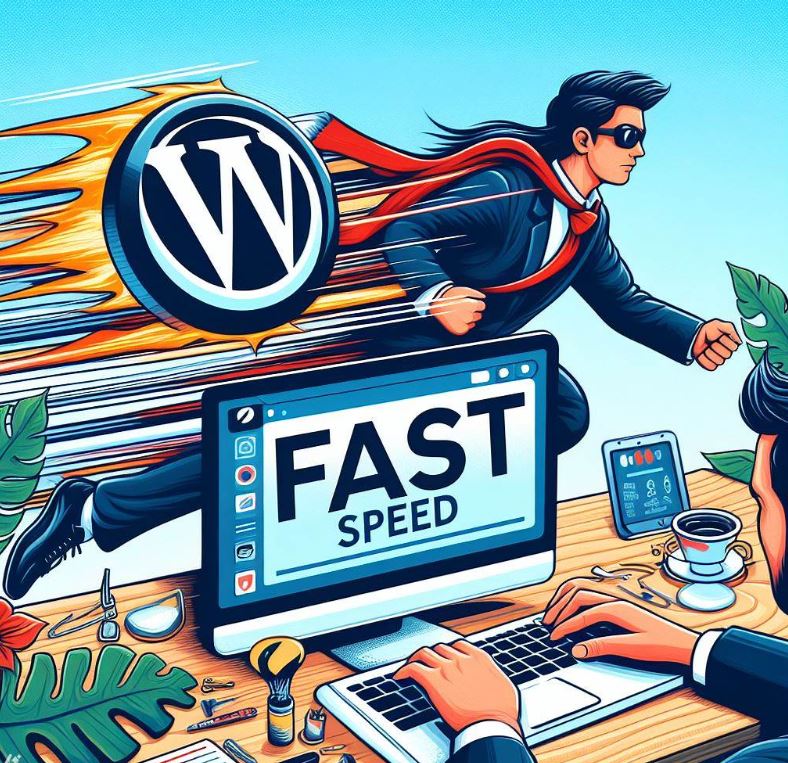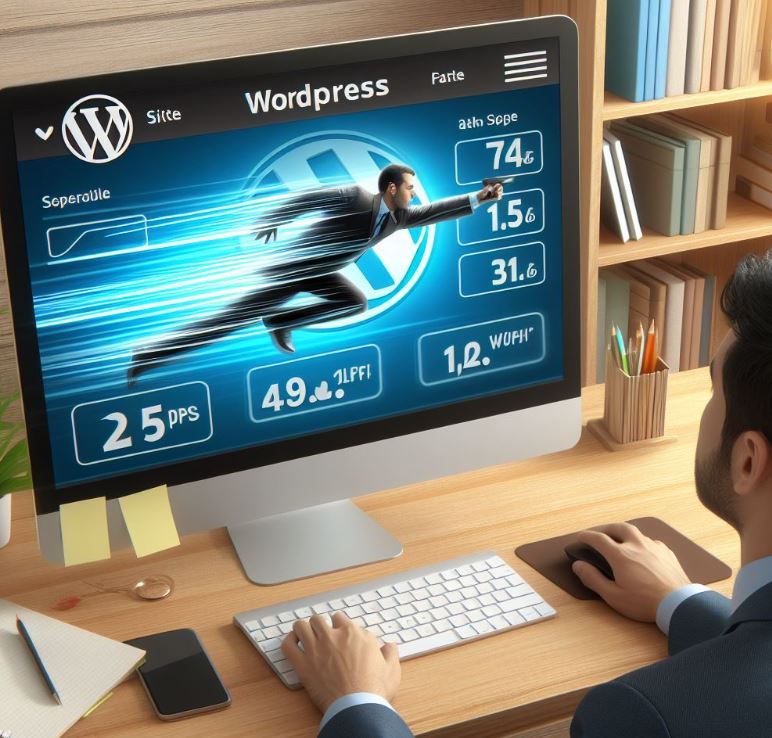Speed is one of the most important factors when it comes to WordPress website performance. A slow website can negatively impact user experience and even hurt search engine rankings. The good news is there are many easy ways to speed up your WordPress site without needing to be a tech expert!
In this comprehensive guide, you’ll learn actionable tips to improve your WordPress site’s speed in 2024 so it loads lightning fast. We’ll cover optimizing your WordPress hosting, themes, plugins, images, and more to boost performance. Let’s dive in!

What Actually Impacts Your WordPress Site’s Speed?
When it comes to WordPress performance, there are a few key areas that can dramatically impact your site’s load times and speed:
- WordPress Hosting – The server your site is hosted on plays a huge role in site speed. Using a managed WordPress hosting provider optimized for WordPress can make your site load up to 20x faster.
- Themes – A poorly coded theme with performance issues can significantly slow down your site. Choosing an optimized theme is key.
- Plugins – Too many plugins or inefficient plugins will bog down your site. It’s best to only use essential plugins.
- Images – Unoptimized images are one of the biggest speed issues. Properly compressing and resizing images is vital.
- Database – A bloated database filled with unnecessary data will slow queries and load times. Regular cleanups help.
Paying attention to these areas gives you the most bang for your buck when increasing site speed. Let’s look at each area more in-depth.
Choose Fast WordPress Hosting
Your WordPress hosting provider has the biggest impact on your WordPress performance. Unfortunately, many cheap shared hosts overload servers, use outdated PHP versions, and don’t utilize caching. This results in slow sites.
The best WordPress hosts fine-tune web servers specifically for WordPress. This includes latest PHP versions, built-in caching, CDNs to serve assets fast, and optimized web server configs.
Migrating to one of these managed WordPress hosts can improve your page load times by multiple seconds and increase site speed by 20x or more. Dramatic improvements!
Some top managed WordPress hosting providers to checkout include Kinsta, WPEngine, Pagely, and WordPress.com VIP hosting.
Pick a Fast WordPress Theme
The next most impactful thing is choosing an optimized premium WordPress theme. Avoid free WordPress themes from marketplaces like ThemeForest… these are notoriously poorly coded and slow.
A well coded theme makes efficient use of database queries, optimizes JavaScript/CSS delivery, and leverages browser caching. This makes your site files load much faster to users.
Using a tool like GTmetrix, test themes before activating them. The faster the page load and higher performance grade, the better. Improvements from 20+ seconds to under 2 seconds are possible by optimizing your theme.
Some fast options include: GeneratePress, Astra, Kadence, OceanWP and Hello Elementor. They build performance best practices right into the theme core code.
Limit Your WordPress Plugins
Plugins provide tons of functionality. But each additional plugin increases load on your server and can hurt WordPress speed.
Most WordPress sites only need 5-10 essential plugins max. Avoid going crazy installing every plugin just because it seems cool. Every single plugin affects site speed.
Also watch out for plugins with background processes, excessive JavaScript, unoptimized images or inefficient code. These compound speed issues.
Use a performance monitoring tool like New Relic or Pingdom to pinpoint sluggish plugins. Deactivate or remove poor performing plugins.
For features like slideshows, galleries, contact forms, etc – use your theme’s built in functionality before installing heavy premium plugins claiming to do the same thing.
Compress Images & Enable Lazy Load
Unoptimized images are one of the #1 issues slowing WordPress sites. Just 1-2 high resolution hero images can drastically spike load times if not properly handled.
Use EWWW Image Optimizer or Shortpixel to compress all the images on your WordPress site by up to 80% without affecting visual quality. This reduces image file sizes from multiple MB to just a few KB.
Additionally, enable a Lazy Load plugin like BJ Lazy Load. This defers offscreen image loading until users scroll down the page. Pages load faster and you save bandwidth on mobile devices.
Finally, make sure your theme properly adds width + height attributes on IMG tags. This improves how quickly images occupy their placeholder space as the page loads.
Following all these image best practices optimizes delivery and visually complete page rendering.
Cleanup Your WordPress Database
Over years of site usage, your WordPress database collects large amounts of cruft. This includes post revisions, unused tables from removed plugins/themes, spam comments and more.
A bloated database causes slower MySQL queries and poor WordPress performance. It also uses up hosting disk space unnecessarily when backups happen.
Using a database cleanup tool like WP-Optimize or WP-Sweep to cleanup and optimize your database helps regain lost performance. Just cleaning spam comments alone can save MB of space.
Set a monthly reminder to scan your database and run optimizations. For most sites, 500mb or less database size is decent. Anything in the multiple GB range likely needs pruning.
Use Caching Plugins
Caching plugins temporarily save rendered pages and reuse this pre-built file to display quicker on repeat visits. This avoids resource intensive database queries and PHP processing WordPress would normally trigger.
Caching is one of the most effective ways to speed up sites when configured properly. Solutions like WP Rocket, WP Fastest Cache and LiteSpeed Cache all have free versions available.
Pro tips for better caching performance:
- Enable browser caching in plugin settings
- Prebuild cache immediately upon content updates
- Customize caching rules per page type
- Use CDN and asset optimization features
With page caching activated, sites see speed improvements of 50-100% on average after initial visit.
Choose Fast Site Location
Where your WordPress server is physically located globally can affect site connectivity speed. Being closer = faster response times.
Ideal locations like Dallas, New York, London, Amsterdam and Singapore ensure most visitors connect quickly without big geographic delays. Scatter servers in a few regions for best coverage.
Using a CDN also helps cache static files closer to website visitors regardless of hosting location. This accelerates asset delivery speed.
If currently hosted far from your audience, migrating hosting locations could shave 500+ ms of load time. Significantly faster global response!
Reduce Redirect Plugins
Many WordPress sites use redirect plugins for forwarding sites after migrations, HTTPS upgrades or URL changes. Over time these build up causing unnecessary extra lookups.
If you have 50+ redirects, performance tools will show warnings on redirect chains causing speed issues. Strip back to essential redirects only by removing old stale rules.
Similarly ensure no plugin auto applies http/http, www/non-www or trailing slash redirects. These double up on WordPress’ built in functionality and slow things down.
301 permanent redirects are particularly troublesome as they prevent full page caching by plugins for the affected URLs. Use sparingly if possible.
By eliminating unneeded redirects, you simplify routing and streamline site loading.
Configure nginx / Apache
Tweaking your web server software configuration can further speed up WordPress site performance. Steps like enabling GZIP compression for text assets, leveraging browser caching of static files, and tuning worker process settings all help.
For nginx, install a FastCGI Cache plugin to cache frequently accessed data in memory. This avoids hitting the database directly as often.
Apache can improve speed by increasing KeepAlive timeout duration and enabling mod_pagespeed / mod_deflate modules for better file compression.
While less crucial than other techniques in this guide, properly configuring your web server stacks up fractional speed gains.
Invest In Optimized Web Fonts
Custom web fonts help a WordPress site stand out visually. However, font files range into the multiple hundred KB range slowing page load.
Switch default fonts used in your theme from generic families like Arial or Times New Roman to font stacks specifically tuned for speed:
- System Font Stack
- Helvetica or Arial
- Verdana and Georgia
These render text just as sharp using files visitors likely already have cached locally. Way faster!
Also optimize font delivery by eliminating extra formats like .woff2, limiting weight/style variants used, and use font subsetting to tailor subsets to just needed glyphs.
Pages with less font bloat achieve faster visual completeness in browsers. Users perceive your site as quicker.

Bonus Tips:
Here’s a few final speed tips for even faster WordPress performance:
✔ Defer loading JS by moving scripts to footer ✔ Load critical CSS inline while optimizing external files
✔ Use partial page caching for heavy dynamic pages ✔ Enable GZIP compression and browser caching ✔ Limit third party embed scripts like social widgets
Getting 20+ seconds trimmed off page load times is completely achievable following the steps outlined in this guide!
Let me know if you have any other questions on speeding up your WordPress website!
Conclusion:How to make WordPress Sites faster
As you can see, speeding up your WordPress website is very achievable by following these performance best practices.
The main areas to focus your optimization efforts are your WordPress hosting environment, sites, themes plugins and images. Configuring these properly makes the biggest impact.
Additional tweaks like database cleanup, using caching plugins, upgrading PHP versions and reducing redirects compound speed gains even further.
In total, by investing some time into the tips covered in this guide, you can expect to shave off 20+ seconds of load time on average. Some sites see performance improvements of 50x or more!
The faster your WordPress site, the happier your visitors and boost to conversions and SEO. It is well worth prioritizing these web vital sign improvements for long term success.